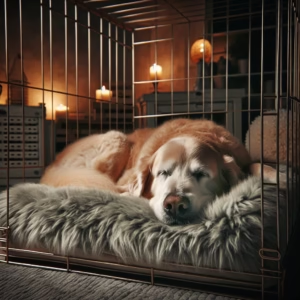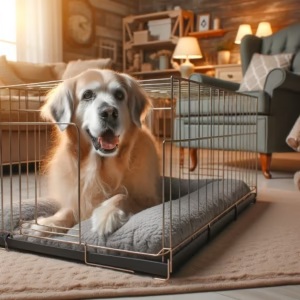Think your adult dog is too old for crate training? Hold that thought.
Whether you’ve just welcomed a rescue pup into your home, need to prep for travel, or you’re dealing with some behavioral hiccups, crate training adult dogs isn’t just possible, it’s actually pretty amazing for both you and your furry buddy.
Here’s the thing about adult dog crate training: it’s different from puppy training, sure. Your grown-up dog comes with baggage (the emotional kind, not the travel kind… yet). They’ve got habits, maybe some trust issues, but guess what? They also have something puppies don’t, focus and attention spans that actually work in your favor.
With the right game plan, some patience, and a good dose of understanding, you can absolutely crate train your dog at any age.
Why Crate Training Actually Works Wonders for Adult Dogs
Look, I get it. Many dog parents think crate training older pets sounds harsh or pointless.
But here’s the real deal: when you do it right, crate training is like giving your dog their own personal sanctuary.
Safety First: Adult dogs, especially those rescue sweethearts, often carry anxiety like a heavy backpack. A properly introduced crate becomes their safe space, their “nope, I’m good right here” zone during thunderstorms, fireworks, or when your in-laws visit unexpectedly. Dogs naturally seek out small, dark, safe spots to inhabit, working with their instinctual desire to be den dwellers.
Behavior Game-Changer: Got a dog who thinks your couch is a chew toy or your trash can is a buffet? Crate training offers a solution that doesn’t involve yelling or punishment. It’s structure, not restriction.
Travel Ready: Planning a road trip or just need to visit the vet? A crate-trained dog travels like a seasoned pro, safer and way less stressed.
Recovery Room: Senior dogs or those bouncing back from surgery need their movement limited sometimes. A cozy crate becomes their healing headquarters.
Separation Anxiety Relief: Dogs accustomed to spending time alone in their own den are much less likely to develop separation anxiety or other phobias and panic disorders.
In case you need to crate train a puppy, I invite you to read : How to Crate Train Your Puppy at Night
The Science Behind Adult Dog Learning
Crate training adult dogs is like learning a new language when you’re 40 versus when you’re 4. Your dog’s brain has patterns, routines, and maybe some not-so-great memories about being confined.
Some rescue dogs? They’ve been through the wringer with improper crating. Fear and anxiety might be their first reaction to anything that looks like a cage.
But here’s the flip side: adult dogs are also incredibly smart. They can focus for longer periods than puppies, they understand cause and effect better, and they thrive on routine once they get it. The trick is working with their personality, not against it.
Research shows that most dogs take between 1 and 4 months to become fully crate trained and comfortable being in a crate without trying to escape. Adult dogs typically need weeks or months to adjust, rather than days, especially those with crate-related trauma in their past.
Picking the Perfect Crate (It’s Like Choosing a Mattress)
Before you dive into training, you need the right setup. Your dog should be able to stand up, turn around, and stretch out comfortably. But don’t go mansion-sized, too much space and they might turn one corner into a bathroom.
Your Crate Options:
- Wire crates: Great for nosy dogs who like to see everything happening around them
- Plastic crates: Perfect for anxious pups who need that cave-like privacy and block out light
- Wooden crates: Fancy enough for your living room, cozy enough for your dog
Got a senior dog with creaky joints? Look for low-entry crates and throw in some orthopedic bedding. Senior dogs with joint pain may not be able to lay down for long periods, so comfort is crucial.
Location Matters: Place the crate in a low-traffic area of your home, but not completely isolated from people. You want it to be quiet but still part of the family environment.
The Real Deal: Step-by-Step Training Process
Phase 1: Making Friends with the Crate (Days 1-3)
Start by making that crate irresistible. Soft bedding, favorite toys, and treats that make your dog do their happy dance, all inside, door wide open. Let them explore without any pressure.
Place the crate in an area where your family spends lots of time, like the family room. Some dogs will be naturally curious and start sleeping in the crate right away.
Pro move: Start feeding meals near the crate, then gradually move that food bowl inside. Food equals good vibes, and good vibes equal crate love. This creates a pleasant association with the crate space.
Phase 2: “Hey, This Place is Pretty Cool” (Days 4-7)
Once your dog is wandering in for treats and meals, start encouraging them with a command like “crate” or “kennel”. Reward the second they step inside, but keep that door open.
If your dog is readily entering the crate, place the food dish all the way at the back. If they remain reluctant, put the dish only as far inside as they’ll go without becoming fearful or anxious.
Try the “Love Your Crate” approach: celebrate every tiny step toward the crate. Looking at it? Good dog! Walking near it? Amazing! Stepping inside? Jackpot! This builds serious positive associations.
Phase 3: Door Closing Time (Days 8-14)
Now for the big moment, closing the door. Start with literally seconds. Once your dog is standing comfortably in the crate to eat their meal, you can close the door while they’re eating.
The first time you do this, open the door as soon as they finish their meal. With each successive feeding, leave the door closed a few minutes longer, until they’re staying in the crate for 10 minutes or so after eating.
Stay close, let them know you’re right there. Gradually increase the time, but don’t rush this part.
If your dog freaks out or begins to whine, you’ve moved too fast. Back up a step and slow your roll.
Phase 4: The Real Test (Weeks 2-4)
After your dog is eating regular meals in the crate with no sign of fear or anxiety, you can confine them for short periods while you’re home.
Call them over to the crate, give them a treat, and use your voice cue to enter. After they enter, praise them, give them the treat, and close the door.
Sit quietly near the crate for 5-10 minutes, then go into another room for a few minutes. Return, sit quietly again, then let them out.
Once your dog will stay quietly in the crate for about 30 minutes with you mostly out of sight, you can begin leaving them crated when you’re gone for short periods.
Golden rule: Never, ever use the crate as punishment. That’ll undo all your hard work faster than you can say “bad dog.”
Special Notes for the Senior Squad
Crate training adult dogs over seven needs some extra TLC. Senior dogs might be dealing with:
- Achy joints: Arthritis, hip issues, or other mobility challenges
- Sensory changes: Hearing or vision loss, possible cognitive changes
- Medical needs: More bathroom breaks, medication schedules
Adjust your approach with extra comfort, shorter training sessions, and more frequent potty breaks. Consider easier-access crates and make sure your senior can get out quickly when nature calls.
Adult dogs who are house-trained can stay in their crate up to 6 hours, but pay attention to your dog’s behavior. Whining and pacing are likely signs they want to be let out.
When Things Go Sideways (Troubleshooting 101)
The Whining and Barking Symphony
If your dog turns into a canine opera singer in their crate, first check the basics, bathroom needs, exercise, pain levels. Persistent whining usually means you’ve pushed too hard, too fast.
Dogs that are not comfortable in crates may excessively whine and bark to be let out. If they start to whine, wait for calm behavior before letting them out.
Fix it: Go back to earlier training phases and rebuild those positive associations before trying longer stays.
Crate Destruction Mode
Some dogs go full Hulk on their crate, scratching, chewing, escape attempts. This is usually anxiety talking, not defiance.
Fix it: Slow down the training, provide engaging toys like puzzle feeders or stuffed Kongs, and consider calming aids like pheromone sprays or relaxing music.
Bathroom Accidents
House-trained adult dogs shouldn’t have accidents in their crate unless something’s wrong medically or they’re super stressed. Dogs are programmed by nature not to soil their dens.
Fix it: Vet check first, make sure the crate isn’t too big, and ensure adequate bathroom breaks before crating.
When to Call It Quits
Most dogs can learn to love their crates, but some situations need different solutions. Dogs with severe separation anxiety, claustrophobia, or certain medical conditions might not be crate candidates.
Red flags:
- Excessive drooling, vomiting, or shaking in the crate
- Self-injury attempts while crated
- Complete refusal despite weeks of positive training
- Regression in house training or other behaviors
If you’re seeing these signs, consider alternatives like dog-proofed rooms, exercise pens, or professional help.
Pro Tips for Crate Training Success
Tire Them Out First: A tired dog is a peaceful dog. Make sure your adult dog gets good physical and mental exercise before crate time. Your dog will likely spend most of the time sleeping once they’re comfortable.
Practice at Home: Try leaving your dog crated while you’re still home before attempting to leave the house. This builds confidence and reduces separation anxiety.
Consistency is Everything: Same commands, same routines, same rewards every time. Adult dogs love predictability.
Make it Exclusive: Save certain high-value treats or toys just for crate time. Try putting a stuffed Kong, bully stick, or safe chewie into the crate for longer periods.
Timing Matters: Wait until your dog is rested and calm before introducing new crate experiences. There’s a better chance they’ll be receptive.
Understanding Crate Time Limits
It’s crucial to understand appropriate crate durations. Once your dog is crate-trained and house-trained fully, you can leave them in a crate for up to 8 hours with good exercise before and after. However, dogs should not be kept in a crate for more than 4 hours without breaks.
Puppies under 6 months shouldn’t stay in a crate for more than 3-4 hours at a time, as they can’t control their bladders or bowels for longer periods. A good general rule for puppies is one hour in the crate for each month of age.
The Veterinary Perspective on Crate Training
According to veterinary behaviorists, crate training works with your pet’s natural desire to be a den dweller. In the wild, nursing wolves and coyotes teach their pups to relieve themselves outside their dens, keeping predators from investigating and maintaining clean sleeping areas.
This natural instinct is exactly why crates are so useful for dogs who haven’t been housetrained yet. A dog with her own den won’t want to soil it, so providing a crate works in harmony with their natural instinct to keep their space clean.
Creating Long-Term Success
Keeping the Good Vibes Going: Once your dog is successfully crate trained, don’t let those positive associations slip away. Keep providing special treats, comfortable bedding, and remember—never use the crate for punishment.
Regular Maintenance: Keep up with crate maintenance too. Clean, comfortable, and properly sized as your dog ages. Senior dogs might need softer bedding or easier access as they develop mobility issues.
Nighttime Crating: Because crates provide a sense of comfort and protection, your dog may enjoy sleeping in them. Make sure your pet is acclimated to their crate before leaving them overnight, though.
Travel Benefits: Crate training makes traveling with your dog extra easy. Riding with your dog in a secured crate keeps them safe on the road, and provides a secure spot in hotels or vacation rentals.
Building Community and Sharing Success
Share Your Journey: We’d love to hear about your crate training experience! Drop a comment below and tell us about your dog’s progress. Did they take to it quickly, or did you face some challenges? Your story could help another dog parent who’s just starting their journey.
Connect with Fellow Dog Parents: Consider joining online communities or local dog training groups where you can share tips, ask questions, and celebrate milestones together. The support of other pet parents can make all the difference.
Document the Process: Take photos or videos of your dog’s crate training journey and share them on social media using hashtags like #CrateTrainingSuccess #AdultDogTraining #RescueDogJourney. You might inspire someone else to give their adult dog this gift of security and comfort.
The Bottom Line
Crate training adult dogs is totally doable with patience, consistency, and the right approach. Sure, it might take longer than training a puppy, most dogs need 1-4 months to become fully comfortable, but the payoff is incredible. Less anxiety, better behavior, safer travel, and a secure space your dog will genuinely love.
Every dog is different. Some adapt quickly, others need weeks or months to fully embrace their crate. The secret sauce is moving at your dog’s pace, keeping things positive, and never using the crate as punishment.
Struggling with the process? Don’t hesitate to call in a professional dog trainer or veterinary behaviorist. With the right guidance and commitment, you can successfully crate train your dog and give them a safe, comfortable space they’ll genuinely love.
Remember, you’re not just training your dog to accept a crate, you’re giving them a gift of security, comfort, and their very own special place in your home.
Ready to start this journey? Begin with picking the right crate and setting up a positive introduction schedule. Your adult dog’s transformation is waiting, and we can’t wait to hear about your success story!
What’s your biggest concern about crate training your adult dog? Share in the comments below, and let’s help each other create happy, crate-loving pups!
Quick Answers to Your Burning Questions
Q: How long does it take to crate train an adult dog?
A: Adult dog crate training typically takes 1-4 months, depending on your dog’s history, personality, and how consistent you are with training. Dogs with rough past experiences might need more time, while some dogs adapt in just weeks.
Q: Can I crate train a 10-year-old dog?
A: Absolutely! Senior dogs can be crate trained, but you might need to make some comfort and health adjustments. Chat with your vet about any physical limitations, especially joint issues that might affect their comfort.
Q: What if my rescue dog is terrified of the crate?
A: Go super slowly, focus on positive associations, and consider getting professional help. Some rescue dogs have trauma related to confinement and need specialized approaches. Never force them, let them set the pace.
Q: How long can I leave an adult dog in a crate?
A: Healthy adult dogs can typically handle up to 6-8 hours during the day, but this varies based on individual needs, age, and health status. Dogs shouldn’t be kept in crates for more than 4 hours without breaks for bathroom, water, and exercise.
Q: Should I cover my adult dog’s crate?
A: Many dogs love crate covers because they create that den-like feeling and reduce visual distractions. Enclosed crates block out light and create more privacy, while wire crates allow your pet to see their environment. Give it a try and see if your dog seems more relaxed.
Resources:
- https://toegrips.com/how-to-crate-train-older-dog/
- https://www.purina.com/articles/dog/behavior/training/how-to-crate-train-adult-dog






